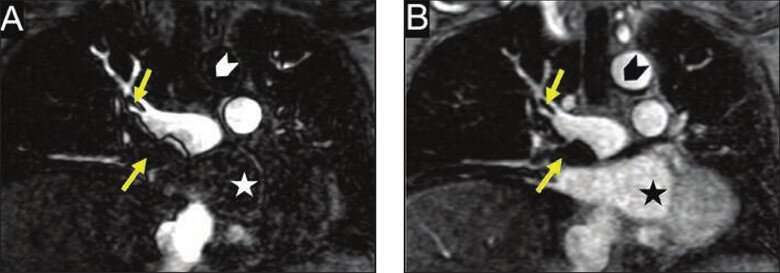This article has been reviewed according to Science X's editorial process and policies. Editors have highlighted the following attributes while ensuring the content's credibility:
fact-checked
peer-reviewed publication
trusted source
proofread
Study supports shift to MR angiography for PE mitigated impact of recent contrast shortage

According to a study published in the American Journal of Roentgenology (AJR), preferential use of pulmonary MR angiography (MRA) for diagnosing pulmonary embolus (PE) in the general population helped conserve iodinated contrast media during the 2022 shortage.
"This single-center experience demonstrates use of pulmonary MRA as a practical substitute for pulmonary CTA in emergency settings," concluded lead investigator Jitka Starekova, MD, from the radiology department of the University of Wisconsin in Madison.
The study included all CTA and MRA examinations performed to exclude PE at their large academic medical center (University of Wisconsin-Madison Hospital and Clinics) from April 1 through July 31 (18 weekly periods) in:
- 2019 (before the COVID-19 pandemic and contrast media shortage),
- 2021 (during the pandemic, though before the shortage),
- 2022 (during both the pandemic, as well as the shortage).
To help preserve iodinated contrast media, from early May through mid-July of 2022, MRA served as the preferred test for PE diagnosis. Upon reviewing CTA and MRA reports, Starekova and her AJR colleagues estimated iodinated contrast media savings via preferential MRA usage.
Ultimately, preferred use of pulmonary MRA to diagnosis PE among the general population conserved (from April 1 to July 31, 2022) an estimated 27 liters of iohexol (Omnipaque) 350mg/ml. During weeks 8-11, more MRA examinations (range, 45-63) than CTA examinations (range, 27-46) were performed.
Noting their AJR study evaluated MRA for PE diagnosis in "an all-comer real-world setting," the present study also includes a larger sample size in comparison to previous research.
More information: MR Angiography as the Preferred Test for Pulmonary Embolism During the Iodinated Contrast Media Shortage of 2022: A Single-Center Experience, American Journal of Roentgenology (2023). DOI: 10.2214/AJR.23.29340. www.ajronline.org/doi/10.2214/AJR.23.29340





















